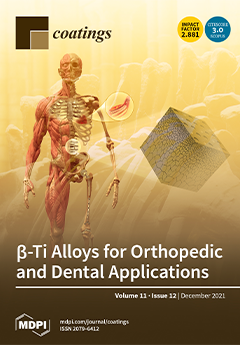This study is aimed at obtaining a coating of aluminum oxide containing α-Al
2O
3 as the main phase by detonation spraying, as well as a comparative study of the structural, tribological and mechanical properties of coatings with the main phases of
[...] Read more.
This study is aimed at obtaining a coating of aluminum oxide containing α-Al
2O
3 as the main phase by detonation spraying, as well as a comparative study of the structural, tribological and mechanical properties of coatings with the main phases of α-Al
2O
3 and γ-Al
2O
3. It was experimentally revealed for the first time that the use of propane as a combustible gas and the optimization of the technological regime of detonation spraying leads to the formation of an aluminum oxide coating containing α-Al
2O
3 as the main phase. Tribological tests have shown that the coating with the main phase of α-Al
2O
3 has a low value of wear volume and coefficient of friction in comparison with the coating with the main phase of γ-Al
2O
3. It was also determined that the microhardness of the coating with the main phase of α-Al
2O
3 is 25% higher than that of the coatings with the main phase of γ-Al
2O
3. Erosion resistance tests have shown (evaluated by weight loss) that the coating with α-Al
2O
3 phase is erosion-resistant compared to the coating with γ-Al
2O
3 (seen by erosion craters). However, the coating with the main phase of γ-Al
2O
3 has a high value of adhesion strength, which is 2 times higher than that of the coating with the main phase of α-Al
2O
3. As the destruction of coatings by the primary phase, α-Al
2O
3 began at low loads than the coating with the main phase γ-Al
2O
3. The results obtained provide the prerequisites for the creation of wear-resistant, hard and durable layered coatings, in which the lower layer has the main phase of γ-Al
2O
3, and the upper layer has the main phase of α-Al
2O
3.
Full article





